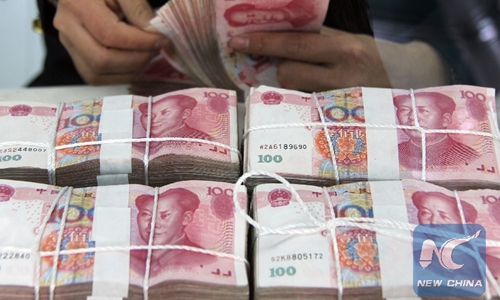HOME >> SOURCE
Yuan’s share of global exchange reserves hits record in Q3 2019: IMF
Source:Global Times Published: 2020/1/5 21:43:40

File Photo: A worker counts Chinese currency renminbi banknotes at a bank in Tancheng County of Linyi City, east China's Shandong Province, April 11, 2013. Photo:Xinhua
The share of global foreign reserves held in the yuan stood at 2.01 percent, equivalent to $219.6 billion, in the third quarter of 2019, the highest level in more than three years, according to a report by the IMF.
The figure compared with 1.97 percent in the previous quarter, according to the IMF report, and it was the highest since October 2016. The yuan's share exceeded the global share of Swiss francs, Australian dollars and Canadian dollars.
The rising status of the yuan as a global reserve currency represents the increasing confidence in the stability and international market potential of the Chinese currency, as well as a global tendency to diversify holdings of foreign exchange reserves, Tan Xiaofen, deputy head at the School of Finance at the Central University of Finance and Economics, told the Global Times on Sunday.
"Rising international demand for the yuan is encouraged by the sound performance of the Chinese economy and the stability of its financial system," Tan said. "It also shows the results of a series of government policies to internationalize the yuan and stimulate long-term demand."
The US dollar still has the largest share of global holdings, but the figure dropped from 66 percent in 2014 to 61.78 percent in the third quarter of 2019, reflecting a global tendency toward diversifying foreign reserves and shifting to currencies of emerging markets, according to Tan.
"As trade among emerging market economies rises, almost every central bank is trying to reduce its holdings in US dollars," Tan said. "It makes trading with the emerging markets easier and can reduce risks from overreliance on the US dollar."
China is now the world's second-biggest economy, and it is also the top exporter and the second-largest importer. It also ranks first in global trade in goods, with trading value exceeding $4.6 trillion in 2018, according to the National Bureau of Statistics.